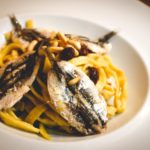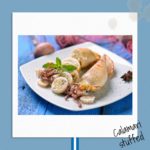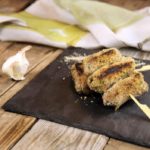LINGUINI WITH ANCHOVIES: EASTERN SUGGESTIONS

The sauce of this unusual linguini with fresh anchovies combines ingredients that are characteristic of Mediterranean cuisine: olive oil, fish, and the introduction of raisins and dried fruit in savoury dishes. This Middle Eastern touch is typical in the cuisine of Italian cities that were in contact with the Arab world for centuries such as Sicily, whose cuisine was deeply influenced by it, like in the case of Sicilian rolls (link to recipe), as well as other cities on the Adriatic and Tyrrhenian Seas, like Venice, Pisa and Genoa, for example.
I had this pasta at Elba, a small beautiful island across from Livorno, rich in iron and exploited since Etruscan times, with a strategic position in the Mediterranean Sea. Pisa and Genoa fought for the dominion of the Tyrrhenian coasts for centuries.
Pisa and Genoa, with Amalfi and Venice were referred to as the Maritime Republics by 19th century historians. They were city-states that were formally independent. During the time of their independence, all these cities had similar (though not identical) systems of government, in which the merchant class had considerable power. Their power and richness came from the economic growth of Europe around the year 1000, together with the hazards of the mainland trading routes, which made the development of major commercial routes along the Mediterranean coast possible. The Maritime Republics’ relationship with the Middle East was constant, alternating periods of peace and fruitful commercial trade with hostility, due to their involvement in the crusades and territorial competition with the Byzantine and Islamic maritime powers. The complex relationship that Italy always had with the Middle East profoundly influenced its cuisine, like this complex sweet and sour taste which cannot be found in other parts of Italy’s cuisine.
Prep Time: 45 minutes | Cooking Time: 15 minutes | Total Time: 60 minutes | Yield: Makes 4 servings.
Ingredients for pasta
- 3¼ cups all-purpose flour (400 grams)
- 4 eggs
Ingredients for sauce
- 300 g fresh anchovies, cleaned*
- 40 g pine nuts
- 3 tbsps. breadcrumbs or a slice of stale bread, chopped with a knife
- 30 g raisins, softened in tepid water
- 1 tbsp fresh parsley, finely chopped
- 4 tbsps. olive oil
Instructions for pasta
On a wooden pastry board, pour the flour in a mound, make a well in its centre and crack the eggs into it. Blend by hand, making a dough that you are going to smooth with a rolling pin. It should be rolled to a 3 mm thickness. Then cut it into rectangles that will be cut on the chitarra.
Cook the pasta in salted water; if it is fresh, it will cook in a few seconds.
The proportion is always 100 g = 1 egg, per person. Of course since the eggs are never regular you might need to add some flour if the dough is too wet or some water if it is too dry and impossible to work.
TIPS:
As you work it, keep the dough near your belly, when kneading and rolling.
Lean into the dough as you work, exploit gravity, not your shoulders and arms.
Instructions for sauce
In a non-stick frying pan, toast the pine nuts for 2 minutes, and chop them roughly.
Sauté the breadcrumbs in a couple of tablespoons of olive oil. When they are golden, add the raisins and pine nuts and sauté together for a minute. Pour everything into a bowl and sauté the anchovies in the same pan for a couple of minutes.
Add the parsley to the other ingredients and mix delicately. Cook the pasta in salted water and add it to the sauce with a couple of tablespoons of its cooking water. Toss with a bit of olive oil and serve.
*Remember to cut off the heads toward the belly and tail, (the direction is important). Pull delicately and the guts will follow too. Insert a finger and detach the spine from the flesh, then break off the spine near the tail.

